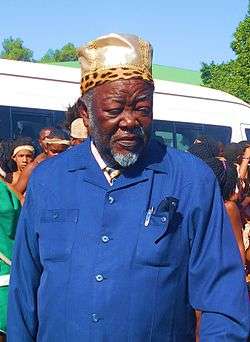Traditional leadership of Namibia
Traditional leadership of Namibia is a governing structure in Namibia based on the ethnicity of the indigenous people of the territory. Acceptance of a traditional authority is vested in the Government of Namibia. There are 51 recognised traditional authorities and a further 40 pending applications.[1]

Traditional authorities cover the entire Namibian territory. Their leaders are entrusted with the allocation of communal land and the formulation of the traditional group's customary laws. They also take over minor judicial work. Leaders and their administrative staff are not paid by the state. Instead the traditional group's members are expected to sustain their leadership. Government did, however, give one car each to the recognised authorities, and awards allowances for fuel and administrative work. The parallel existence of traditional authorities and the Namibian government in Namibia is controversial.[1]
Recognised traditional authorities
| Traditional authority [1] | Locale | Current leader [1] and title |
|---|---|---|
| Mbunza | Alfons Kaundu | |
| Sambyu | Angelina Matumbo Ribebe | |
| Gciriku | Ndiyona Constituency of the Kavango Region | Hompa Kassain Shiyambi |
| Uukwangali | Nkurenkuru | Daniel Sitentu Mpasi |
| Mbukushu | Erwin Mbambo Munika | |
| Ondonga | Onamungundo Ondangwa | Elifas Shuumbwa Nangolo |
| Uukwaluudhi | Tsandi | Josia Shikongo Taapopi |
| Ongandjera | Okahao | Johannes Jafet |
| Uukwambi | Elim | Iipumbu Herman Iipumbu |
| Ombalantu | Oswin Mukulu | |
| Uukolonkandhi | Daniel Shooya | |
| Oukwanyama | Ehole | Martha Nelumbu |
| Ombandja | Okalongo | Matias Walaula |
| Masubia | Bukalo, Zambezi Region | Kisco Liswani III |
| Mafwe | Chinchimane, Zambezi Region[2] | Gerge Simasiku Mamili |
| Mayeyi | Boniface Lutibezi Shufu | |
| Mashi | Joseph Tembwe Mayuni | |
| ǀGowanîn | across the Kalahari Desert | Gariseb Stefanus |
| ǀKhomanin | in the Khomas Highland | vacant |
| ǃOeǂGan | of the Erongo Mountains, Usakos, and Ameib | Immanuel ǂNu-axa |
| Tsoaxudaman | along the Swakop River | Betuel Haraseb |
| ǀGaiodaman | along the Omuramba Omatako between Outjo and the Waterberg | J M Haraseb |
| ǂAodaman | between Kamanjab, Outjo and Otavi | Ukongo Petrus |
| Dâuredaman | Brandberg and vicinity | Elias Taniseb |
| ǀKhowesin (Witbooi Nama) | Gibeon[3] | Christian Rooi (acting) |
| Bondelswart | vacant | |
| Soromaas | David Fredericks | |
| Khaiǁkhaun (Red Nation) | Hoachanas | Petrus Simon Kooper |
| ǂAonin (Southern Topnaars) | Rooibank and other settlements along the lower Kuiseb River | Seth Kooitjie |
| Afrikaner | vacant | |
| ǁKhauǀgoan (Swaartbooi Nama) | Rehoboth, Salem, Ameib, and Franzfontein[4] | Daniel Luipert |
| Blouwes | Blouwes | vacant |
| Vaalgras | Vaalgras | Joel Stephanus |
| ǃKharakhoen (Fransman Nama) | Amper-Bo[5] | vacant |
References
- Tjitemisa, Kuzeeko (18 November 2016). "Chiefs cost govt millions". New Era. p. 6. The list of currently recognised traditional authorities only appears in the print version.
- Tashaya, Clemence (5 July 2011). "Mafwe prepares to celebrate their annual "Lusata" cultural festival". New Era via allafrica.com. Archived from the original on 12 January 2013. Alt URL
- Dedering, Tilman (1997). Hate the old and follow the new: Khoekhoe and missionaries in early nineteenth-century Namibia. 2 (Missionsgeschichtliches Archiv ed.). Franz Steiner Verlag. pp. 59–61. ISBN 978-3-515-06872-7. Retrieved 24 November 2016.
- Malan, Johan S (1998). Die Völker Namibias [The Tribes of Namibia] (in German). Windhoek, Göttingen: Klaus Hess. pp. 120–125.
- Cloete, Luqman (2 February 2016). "ǃKhara-Khoen Nama sub-clan installs leader". The Namibian.